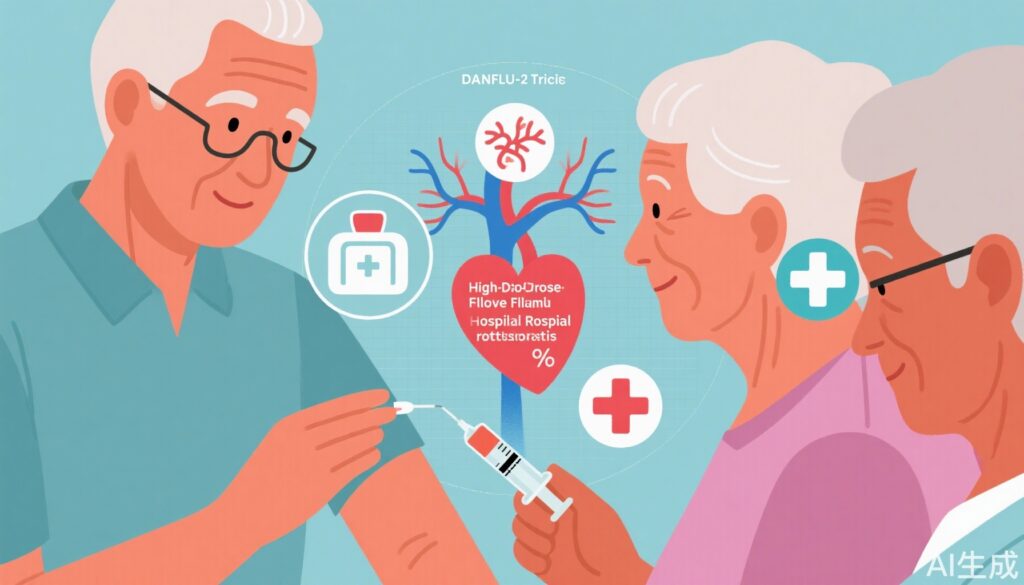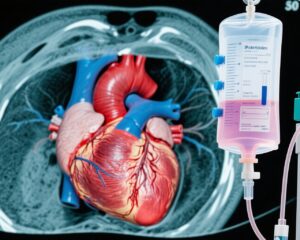Highlights
- The DANFLU-2 trial is the largest individually randomized influenza vaccine trial, enrolling over 330,000 older adults in Denmark.
- High-dose inactivated influenza vaccine (HD-IIV) shows superior protection against cardiovascular (CV) and cardiorespiratory hospitalizations compared to standard-dose (SD-IIV), despite a neutral primary endpoint regarding influenza hospitalization.
- Vaccine effectiveness was consistent in participants with or without pre-existing atherosclerotic cardiovascular disease and heart failure, indicating broad applicability in older populations.
- Integration of patient-reported outcomes and home self-swabbing in a substudy demonstrated feasibility for decentralized disease monitoring in large pragmatic trials.
Background
Influenza infection poses a substantial health burden in older adults, particularly due to its association with cardiovascular complications such as myocarditis, heart failure exacerbations, myocardial infarction, and stroke. Standard-dose inactivated influenza vaccines (SD-IIV) are recommended in this population; however, age-related immunosenescence diminishes vaccine immunogenicity and effectiveness. High-dose inactivated influenza vaccines (HD-IIV) have been developed to enhance immune response and have demonstrated superior protection against laboratory-confirmed influenza infection. Nonetheless, robust evidence from large randomized controlled trials (RCTs) evaluating their impact on severe cardiorespiratory and cardiovascular outcomes in the elderly general population has been lacking. The DANFLU-2 trial was designed to address this critical knowledge gap.
Key Content
Trial Design and Population
DANFLU-2 is a pragmatic, open-label, individually randomized trial conducted across the 2022/2023 to 2024/2025 influenza seasons in Denmark, enrolling 332,438 adults aged ≥65 years without exclusion based on comorbidity status. Participants were randomly allocated 1:1 to receive either HD-IIV or SD-IIV each season, with re-randomization if enrolled over multiple seasons. The trial utilized nationwide administrative health registries for baseline and outcome data collection, enabling comprehensive follow-up for hospitalizations and mortality. The primary endpoint was hospitalization for influenza or pneumonia, with secondary endpoints including hospitalization for any cardiorespiratory disease and cardiovascular-specific outcomes.
Effectiveness on Influenza and Cardiorespiratory Outcomes
Although HD-IIV did not significantly reduce the primary endpoint of hospitalization for influenza or pneumonia, a statistically significant reduction was observed in hospitalization for any cardiorespiratory disease when compared to SD-IIV (relative vaccine effectiveness [rVE] 5.7%; 95% CI, 1.4% to 9.9%). Hospitalizations for cardiovascular diseases were also fewer in the HD-IIV group, with an rVE of 7.5% (95% CI, 1.5% to 12.5%). Notably, hospitalizations for heart failure were reduced by 19.5% (95% CI, 3.3% to 33.1%) with HD-IIV. These findings suggest that HD-IIV may confer clinically relevant cardioprotective benefits beyond influenza prevention.
Subgroup Analyses: Atherosclerotic Cardiovascular Disease and Heart Failure
An exploratory analysis comparing vaccine effectiveness among participants with and without pre-existing atherosclerotic cardiovascular disease (ASCVD) found no significant heterogeneity, with similar rVE estimates for the primary and cardiovascular endpoints. Specifically, the rVE for influenza hospitalizations was approximately 43-46% regardless of ASCVD status, and no significant reduction in major adverse cardiovascular events (MACE) was detected, possibly due to low event rates or other trial limitations.
In participants with heart failure (HF), representing over 10,000 individuals, HD-IIV was associated with lower hospitalization rates for influenza-related illness, lab-confirmed influenza, cardiovascular disease, and heart failure hospitalizations compared to SD-IIV. Effect estimates showed relative risk reductions ranging from 11% to 52%, although many confidence intervals crossed unity. Consistency of effects across HF subgroups, including disease duration, biomarker levels (NT-proBNP), and device therapy status, supports the robustness of these observations.
Safety Considerations: Myocarditis and Pericarditis Risk
A prespecified secondary analysis examined the risk of myocarditis and pericarditis following HD-IIV versus SD-IIV administration. Although data are limited, no increased risk was detected with the high-dose vaccine, reassuring its safety profile in older adults.
Innovations in Trial Methodology: Home Self-Swabbing and Patient-Reported Outcomes
The DANFLU-2 trial incorporated a pragmatic substudy evaluating feasibility of home-based self-swabbing and digital patient-reported outcome (PRO) collection for influenza-like illness (ILI) monitoring. Among nearly 2,000 enrolled participants, compliance with 14-day symptom diaries (RiiQ™) was high (85.7%), and self-swabs were timely and largely correctly registered for PCR testing. Participant feedback favored self-swabbing over clinic visits, though withdrawal rates suggested the need for optimized engagement strategies. This novel approach exemplifies leveraging digital tools in large-scale vaccine effectiveness trials.
Trial Design Insights and Health Economic Considerations
As the largest individually randomized influenza vaccine trial to date, DANFLU-2 used innovative electronic recruitment and online consent processes with comprehensive registry linkage. Hierarchical testing of all-cause hospitalization and mortality endpoints, combined with ancillary analyses on cost-effectiveness and healthcare resource use, will provide critical data for public health policies regarding optimized influenza vaccination strategies in older adults.
Expert Commentary
The substantial sample size and pragmatic design of DANFLU-2 represent a major advancement in evaluating influenza vaccine effectiveness on hard cardiovascular outcomes in the elderly. The neutral primary outcome of hospitalization for influenza or pneumonia may reflect seasonal variability or diagnostic challenges; however, the observed cardioprotective effects of HD-IIV hold biological plausibility given influenza’s role as an acute inflammatory trigger of cardiovascular events.
Consistent benefits across ASCVD and HF subgroups highlight the potential for HD-IIV to reduce influenza-triggered cardiovascular complications in vulnerable older populations. The lack of increased myocarditis/pericarditis risk further supports its safety, addressing concerns that high-dose vaccines might potentiate immune-mediated inflammatory events.
The incorporation of digital PROs and home-based diagnostics in the trial illustrates the growing role of decentralized methodologies in infectious disease research, which may improve data quality and participant convenience.
Limitations include the open-label design, potential residual confounding despite randomization, and the exploratory nature of secondary endpoints given the neutral primary result. Further analyses and ongoing seasonal data will refine understanding of vaccine impact across diverse clinical outcomes.
Current clinical guidelines recommending influenza vaccination for cardiovascular risk reduction may consider HD-IIV preferentially in older adults based on these findings, balancing improved effectiveness with cost and availability.
Conclusion
The DANFLU-2 trial provides robust evidence that high-dose influenza vaccination in adults aged ≥65 years reduces hospitalizations for cardiovascular and cardiorespiratory diseases compared to standard dosing, particularly lowering heart failure events. These data support the use of HD-IIV as an effective preventive strategy to mitigate influenza-associated cardiovascular morbidity in the aging population. The trial’s innovative methodology and ongoing follow-up will further inform optimal influenza vaccination policies and strategies to reduce respiratory and cardiovascular disease burden.
References
- Stokholm MG et al. High-Dose vs Standard-Dose Influenza Vaccine and Cardiovascular Outcomes in Older Adults: A Prespecified Secondary Analysis of the DANFLU-2 Randomized Clinical Trial. JAMA Cardiol. 2025 Aug 30:e253460. doi:10.1001/jamacardio.2025.3460. PMID: 40884442.
- Stokholm MG et al. High-dose vs standard-dose inactivated influenza vaccine and cardiovascular outcomes in persons with or without pre-existing atherosclerotic cardiovascular disease: the DANFLU-2 trial. Eur Heart J. 2025 Aug 30:ehaf678. doi:10.1093/eurheartj/ehaf678. PMID: 40884413.
- Kristensen SL et al. High-Dose vs. Standard-Dose Influenza Vaccine in Heart Failure: A Prespecified Analysis of the DANFLU-2 Trial. Circ Heart Fail. 2025 Aug 30. doi:10.1161/CIRCHEARTFAILURE.125.013678. PMID: 40884411.
- Kristensen SL et al. Risk of Myocarditis or Pericarditis With High-Dose vs Standard-Dose Influenza Vaccine: A Prespecified Secondary Analysis of the Randomized DANFLU-2 Trial. JAMA Netw Open. 2025 Aug 1;8(8):e2536889. doi:10.1001/jamanetworkopen.2025.36889. PMID: 40884443.
- Bains S et al. Patient-reported outcomes and home-based self-swabs for influenza-like illness events – lessons learned from the 2023/2024 DANFLU-2 Homeswab PRO substudy. J Patient Rep Outcomes. 2025 Aug 22;9(1):108. doi:10.1186/s41687-025-00936-8. PMID: 40844659.
- Kristensen SL et al. A pragmatic individually randomized trial to evaluate the effectiveness of high-dose vs standard-dose influenza vaccine in older adults: Rationale and design of the DANFLU-2 trial. Am Heart J. 2025 Jul 30:S0002-8703(25)00287-X. doi:10.1016/j.ahj.2025.07.069. PMID: 40749884.


